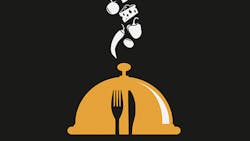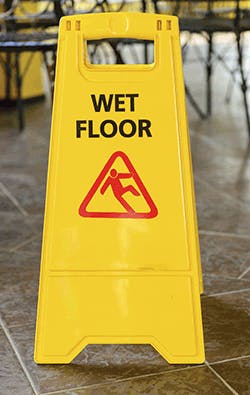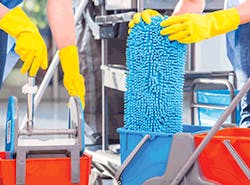With the many hazards found in kitchens and restaurants – water, ice and grease on the floor; spilled food; condensation; people in and out; hot pans and plates full of food – it's not surprising that slips and falls are a concern. Many of the causes of slips and falls at restaurants and commercial kitchens can be found at workplaces in other industries, and the lessons learned the hard way by the hospitality industry can be valuable to other industries as well.
"Slips and falls statistically land at the top of the list of accidents that occur in food service kitchens," says Jeff Nelken, a food safety expert and trainer. "You look at why they occur – wet, sticky and greasy floors, fast-moving employees, shoes that aren't slip-resistant, food on the floor, multiple elevations – and you try to increase awareness among employees about what's going on around them."
He calls this kind of training "creating a 'pre-fall awareness.'"
A Step in the Right Direction
Nelken works with employers around the country to help them spot hazards and either eliminate them, reduce the chance of them causing an incident or train employees to spot them and manage them.
"I start by asking them what accidents or near accidents they've had in the last year," says Nelken. "I hear things like, 'We had some slips near the ice machine. There always is water there.'"
He said employees tell him they trip over the edges of the rubber maps that are placed to reduce slips, trips and falls, making the mats the actual trip hazard. Nelken suggests purchasing strips that are made to "snap" the mats together, so that workers aren't traveling between different levels (flat, slick floor versus raised, non-slip mat). He also pointed out that sometimes, the grip on the mats themselves no longer is effective, and the mats slide around.
"I'll see towels placed under the mats," says Nelken. "I ask about it and I'm told that when the floor gets wet, the mats slide around. Easily 75 percent of the time, the mats are not maintained. Over time, they lose the ability to grip the floor. Certain cleaning products degrade them. I tell owners: 'Think of them like your car tires. You need to measure the depth of the tread of your tires with a penny to make sure they are safe. You need to check the 'tread' on your mats too.'"
He also recommends that employers research cleaning products and floor coatings. Certain cleaning products contain additives that do double duty: they clean the floor but also provide some traction. There are floor coatings available that also can give floors some traction, he says, noting that Trader Joe's stores use them and are examples in action.
"Ask yourself: What makes floors slippery? Is it water, grease, condensation, spilled food? Try to eliminate or manage whatever that slip hazard is," says Nelken.
Keep floors as dry and clean as possible and encourage employees to mop up spills when they see them. If they know they are going to be dropping frozen food into a fryer, then there's going to be oil splatter on the floor that needs to be cleaned up before someone slips. If they're using a slicer, juice might drip on the floor and they need to be aware of that. Employees are the first line of defense in reducing slip hazards, he says.
Shoes Wisely
Workers on construction sites and in manufacturing facilities know that they need to wear appropriate footwear for their industry. The hospitality industry is no different when it comes to requiring appropriate footwear. Comfort is a concern, of course, but so is protection. Choosing the right shoes can make all the difference, says Nelken.
"Some employees come in wearing 'street' shoes – leather shoes with leather soles or athletic shoes. That's not appropriate for a kitchen," he says. "There is non-slip footwear out there and that's what employees should be wearing."
He says he doesn't see proper footwear in kitchens as often as he'd like. He tells his clients to contact footwear manufacturers that sell lines of shoes made specifically for the hospitality industry. Often, those manufacturers or their distributors can bring out mobile "shoe stores" so that employees can try on and purchase appropriate footwear.
"These companies are more than happy to come out and talk to your employees and demonstrate the shoes and talk about appropriate footwear. Use that resource," Nelken advises.
In addition to slip-resistant shoes, employees who work around knives or hot grease have to be aware of those hazards and ensure that if they drop a knife or a hot pan on their feet, that their shoes will offer protection from injury.
Other Slip-and-Trip Hazards
Nelken also identifies a number of other slip, trip and fall hazards for hospitality workers. Entry ways, where customers come in with wet shoes or boots or dripping umbrellas, can be hazardous to employees and customers alike. Many restaurants have what Nelken calls "rainy day" mats that are used only on days when the floors might be wet. Some restaurants offer disposable "sleeves" for umbrellas, so they are not left to drip on the floor.
Bathrooms can be trouble spots. Locate towels or towel dispensers next to sinks, so that guests who have washed their hands aren't dripping water across the bathroom floor in an attempt to grab a towel. Assign an employee to check bathrooms frequently (once an hour) and keep the floors clean and dry.
Nelken also suggests offering bloodborne pathogens training for employees and having a spill kit for bloodborne pathogens and bodily fluids, like vomit, on hand. Guests sometimes get sick and employees need to know the proper, safe way to clean the area. Also, kitchens have knives and slicers and incidents happen, so employees need to know how to protect themselves and the food from bloodborne pathogens.
Areas where there is a buffet usually have spilled food and splashes of water, ice, salad dressing or food around them. Assign an employee to keep an eye on that area and mop when necessary.
Finally, says Nelken, remind employees to "be aware." Do it verbally and do it with signage, particularly in areas where spills are common, like around walk-in coolers, dishwashing areas and ice machines. "Encourage awareness that someone is moving through the kitchen quickly, that someone is behind you with a hot pan, that someone is carrying a stack of wet plates from the dishwasher, that there's usually some water on the floor by the ice machine. Be aware."
During training for employees, Nelken reminds them to not only look in front of them, but also to use their peripheral vision to see what's coming at them from either side and to let others know when they're walking behind them.
He also reminds restaurant managers and operators to have standard operating procedures (SOPs) for everything from cleaning the floors and servicing the mats to emptying fryers, cleaning slicers and taking out the garbage. He reminds them to keep those SOPs where employees can see them while they are doing those tasks.
"They all have them, but they're in a book somewhere and no one even knows where the book is," says Nelken. "If you don't know what those procedures are and you can't look them up, then you can't be expected to do them and that's when people get hurt."
Restaurants and food service operations typically have small margins, he notes, so, "The safer you make your operation, the more money you can save and the more costs you can cut and the more profitable you can be."
10 Risk Factors for Slips and Falls in the Hospital Industry
A study a few years ago from Kaivac Cleaning Systems and Zurich Services Corp. identified these 10 risk factors as those most closely associated with slips and falls in the hospitality industry.
- Surface composition of floors – How much slip resistance does the floor have when dry and properly cleaned? Some hard surface floors may be slip-resistant when dry, but very slippery when wet or soiled.
- Foreign substances – Ice, grease and water are major contributors to hazardous floors. Conventional mopping, particularly with dirty mop water, can make the problem worse, so consider a "no touch" cleaning system or a mop bucket that has separate compartments for clean and dirty water.
- Surface conditions – Raised or recessed edges, loose carpeting, soiling and overall cleanliness of the floor can all be factors.
- Surface changes – For example, walking from a carpeted floor to a tile floor can cause someone to trip.
- Level changes – Unexpected slopes in the floor or raises of three steps or less can contribute to accidents.
- Obstructions – Extension cords, hoses and even floor-level "wet floor" signs can make for an unsafe obstacle course.
- Visibility – Poor lighting, glare, shadows, too-bright lights and color contrasts all can impede visibility.
- Human factors – These include different physical abilities, physical challenges, shoe types and familiarity with a certain area.
- Stairs – Falls from stairs (defined as more than three steps) typically result in the most serious injuries.
- Unusual features – This is defined as anything that could distract a walker, such as loud noises and strobe or flashing lights.
About the Author

Sandy Smith
Sandy Smith is the former content director of EHS Today, and is currently the EHSQ content & community lead at Intelex Technologies Inc. She has written about occupational safety and health and environmental issues since 1990.


